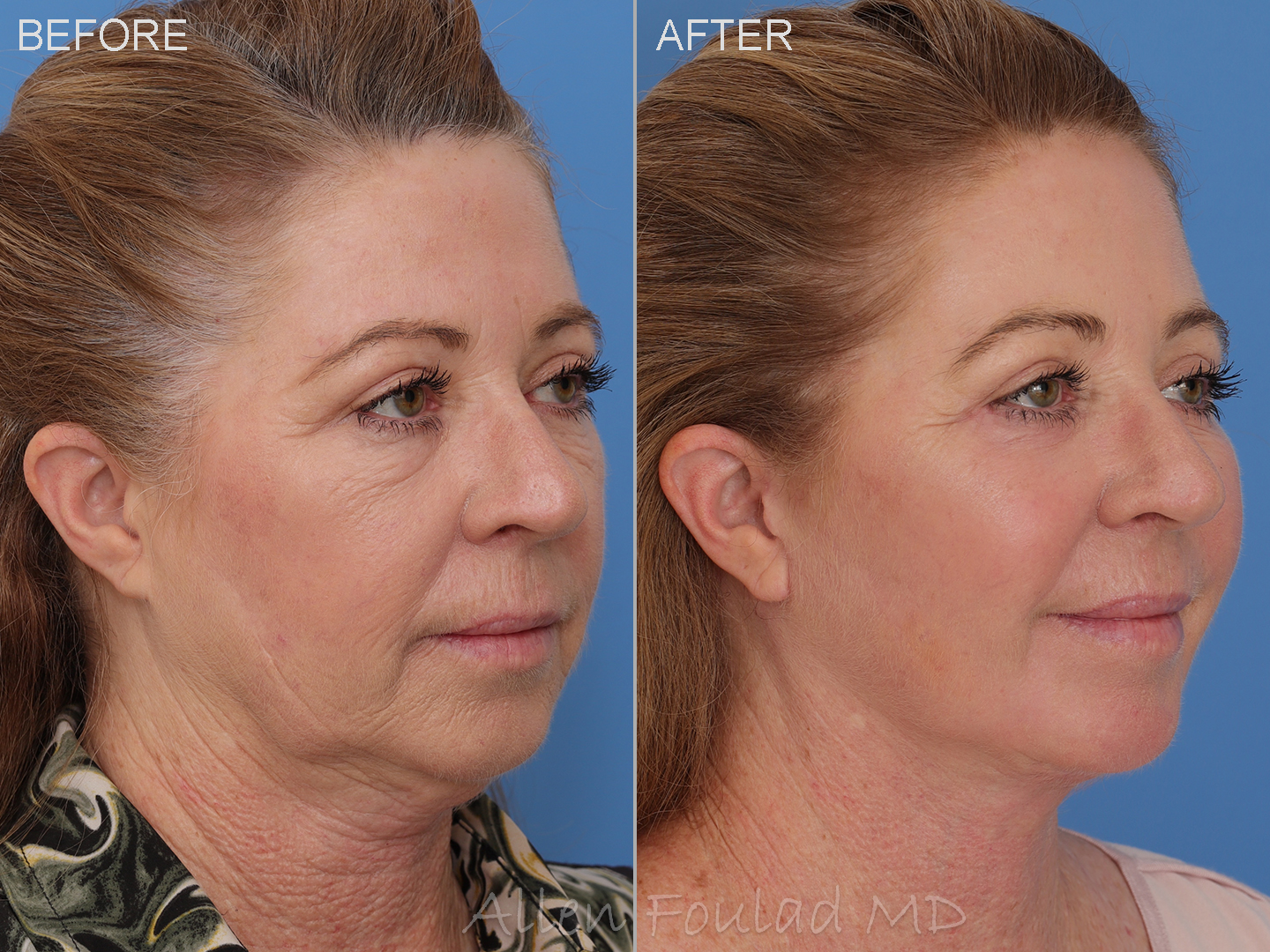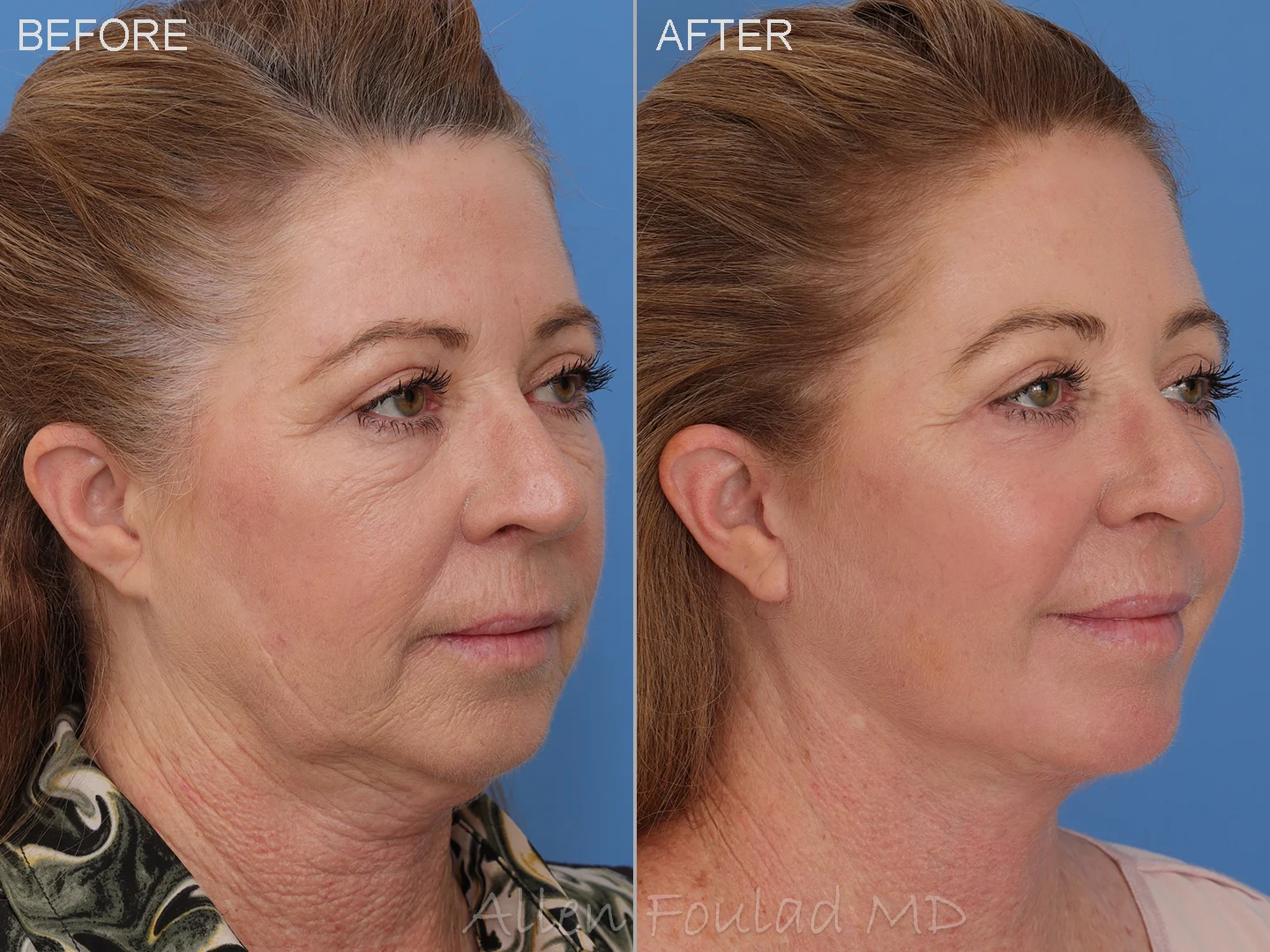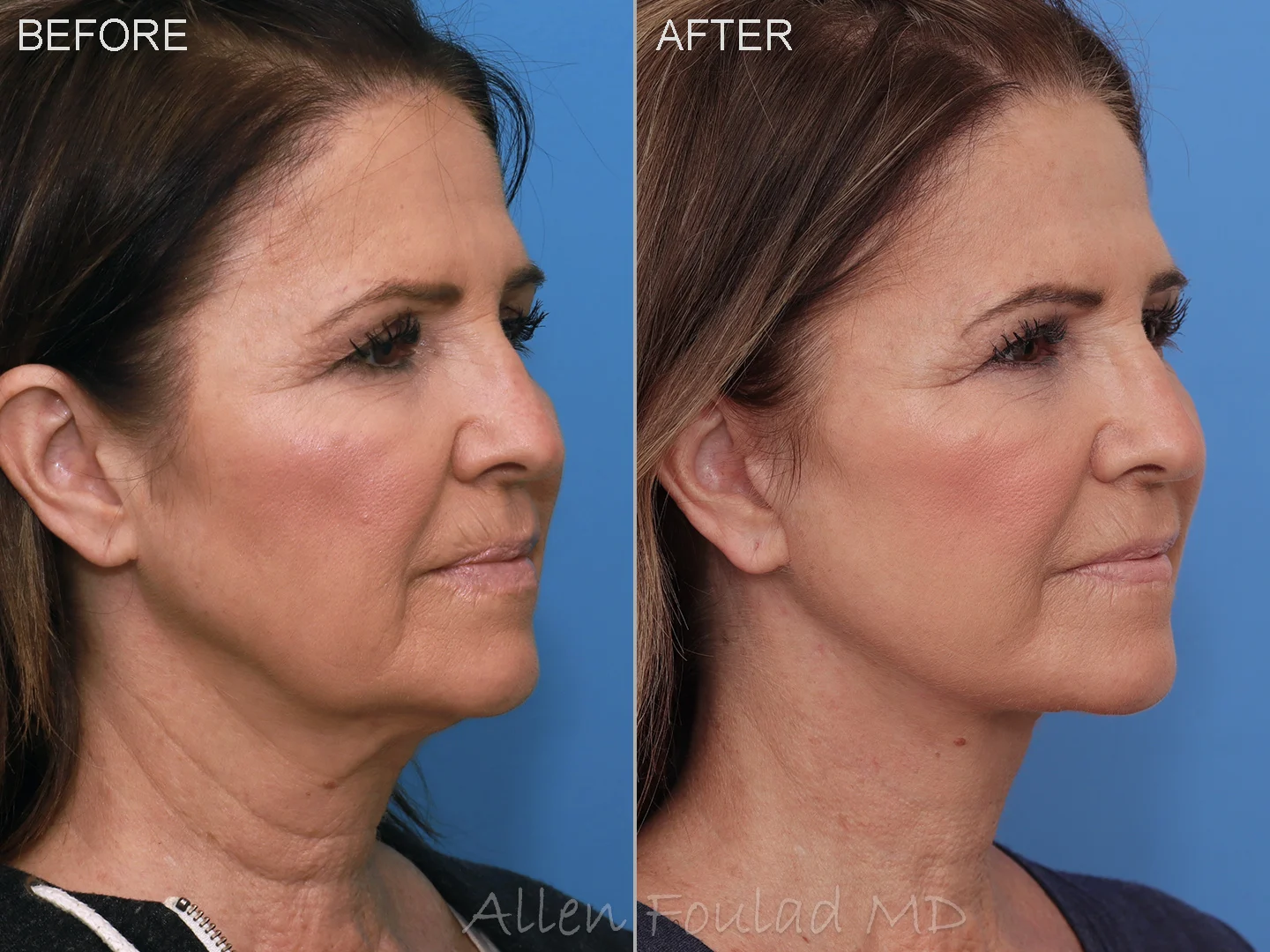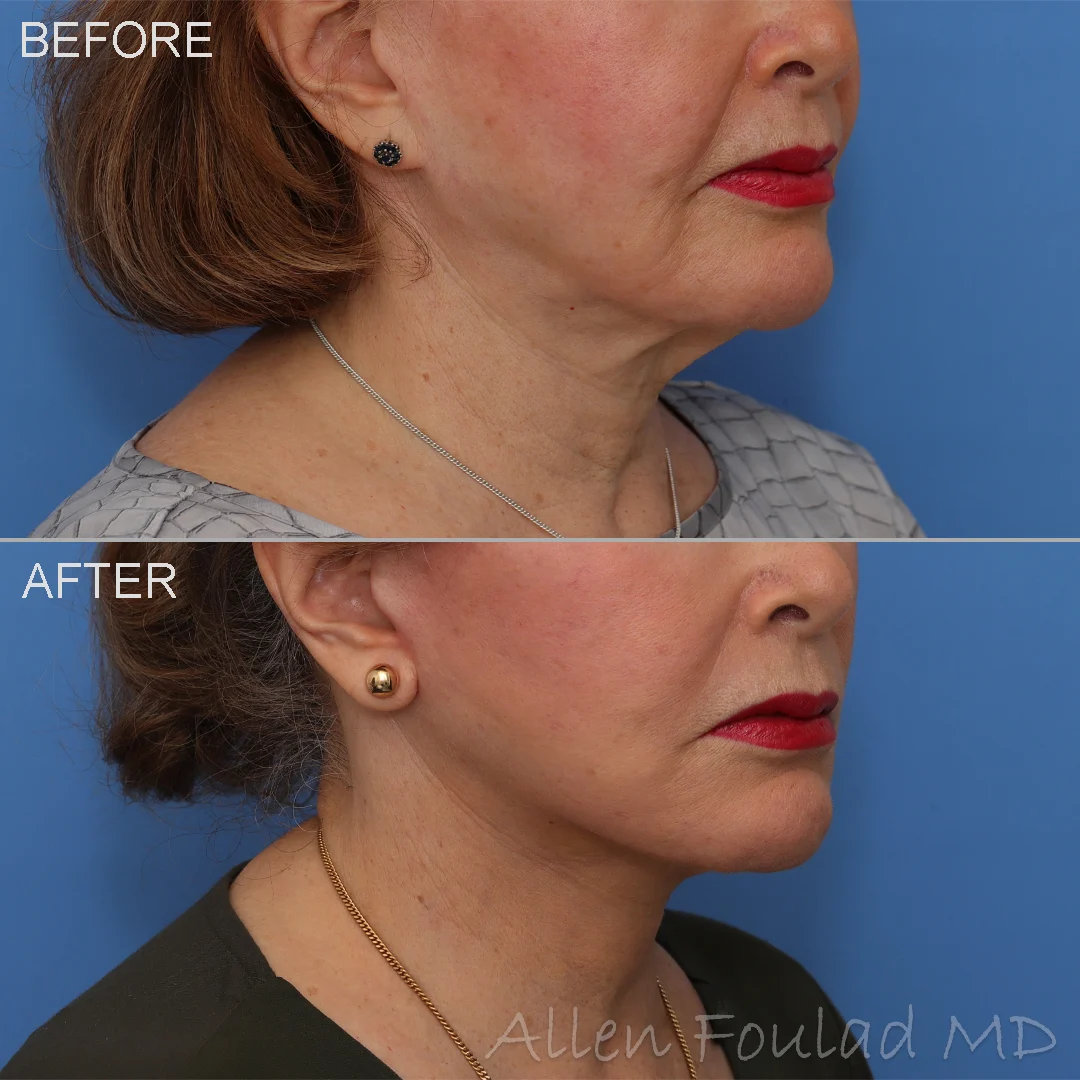Dr. Foulad’s Signature Facelift
Dr. Foulad performs an advanced technique known as the Extended Deep Plane Facelift—one of the most effective options for achieving natural, long-lasting facial rejuvenation. This procedure involves lifting the deeper facial tissues beneath the SMAS (Superficial Musculoaponeurotic System) layer, allowing for a true repositioning of sagging structures rather than simply pulling the skin tight.
A key advantage of this method is the ability to lift the tissues with little to no tension. By thoroughly releasing the underlying structures, Dr. Foulad can reposition the sagging tissues of the face in a more youthful and natural direction—primarily vertically—while avoiding the telltale signs of a facelift, such as tightness around the mouth, visible tension lines, pixie ears, or an overly pulled appearance.
This technique also results in less tension on the incision sites, which helps reduce the risk of wide or visible scars. Dr. Foulad is known for his meticulous attention to detail, taking extra time to carefully suture the incisions for the best possible aesthetic outcome.
Patients frequently share how natural their results appear—refreshed and more youthful, yet still completely true to themselves. Dr. Foulad’s technique is designed to preserve each individual’s unique facial identity and avoid over-correction.
A Neck Lift is often performed with a facelift in order to lift the sagging tissues of the face and neck as a single unit. A neck lift improves the contour of the neck and treats sagging and loose skin. To perform a neck lift, an incision is created under the chin and/or behind the ears. Through these incisions, the plastysma muscle can be tightened. Any excess, sagging skin is also trimmed and removed. Muscle lifting techniques must also be implemented. This approach delivers results that appear much more natural and remain sustainable over time. A Deep Neck Lift involves contouring the structures under the platysma muscle, such as by reducing the subplatysmal fat, digastric muscles, and submandibular glands. To restore an optimal appearance of the neck, it is typically very important that the outer skin on the neck is not solely tightened. A deep neck lift is the most common type of neck lift that Dr. Foulad performs.
Other Facelift Techniques
As the name implies, Skin-Only Facelift involves surgery limited to the skin. Excess skin is removed, but the deeper tissues are not treated. Dr. Foulad does not recommend this type of technique. This is because the results do not last long and can be associated with an unnatural and “tight” appearance, as well as increased risk for more visible scars.
A SMAS Facelift not only removes excess skin, but also tightens the SMAS layer. SMAS stands for Superficial Muscular Aponeurotic System, and this layer of tissue is located between the skin and the underlying muscles of the face. A SMAS facelift tightens the SMAS layer, which helps pull up the sagging tissues of the face. Compared to only removing excess skin, tightening the SMAS layer results in improved and longer lasting results. However, due to the significant tension required in this approach—even though it is primarily limited to the SMAS layer—Dr. Foulad generally avoids this technique and prefers techniques that minimize tension.
Candidates for Facelift
Candidates for facelift and neck lift surgery include women or men who are experiencing signs of sagging and loose skin at the region of the mid face, lower face, and neck. Ideal patients are in good overall health and have skin that has retained some flexibility and elasticity. It is important that patients do not smoke or use nicotine products before and after the procedure. The typical age of our patients undergoing face lifting is 40 to 70 years old, however there is no standard age range. Candidates for the procedure are based on indications, which includes jowls, sagging of the cheeks, platysma banding, and excess skin. Dr. Foulad will perform a thorough evaluation to help you decide which surgery or alternative treatment would best meet your goals.
How to Prepare for Facelift
In preparation for undergoing facelift and neck lift surgery, medical evaluation by your primary care provider is required to ensure that you are healthy and optimized for the procedure. Certain medications and supplements might have to be stopped a specific time period prior to the procedure to reduce certain risks. It is important that you do not not smoke or use nicotine products 1-2 months prior to your procedure. You will be provided more comprehensive pre-operative instructions specific to your individual case.
We are conveniently located to serve Beverly Hills, West Hollywood, & Los Angeles. However, we are available to help with coordinating your stay if you are an Out-of-Town Patient.
What to Expect After Facelift
Most patients experience only mild discomfort after surgery. For those who do have more significant pain, Dr. Foulad provides a personalized and optimized pain management plan to ensure your comfort throughout the recovery process. In many cases, sleeping with your head and back elevated for the first week is recommended to help minimize swelling.
Swelling and bruising tend to peak around day 3 to 4. By the two-week mark, most of this has subsided enough for patients to comfortably return to work and social activities. Makeup can typically be applied at this point to help conceal any residual bruising, if desired.
Patients often feel very pleased with their results between two and four weeks. While there is already significant improvement at this time, it’s important to understand that full healing continues over the following months as micro-swelling gradually resolves.
For more detailed guidance, please review our general post-operative care instructions, which cover important recommendations for a smooth recovery.
Schedule Your Facelift Consultation
If you’re ready to explore how a facelift can help you achieve natural and long-lasting rejuvenation, we invite you to schedule a consultation with Dr. Foulad. Our team is here to answer any questions you may have and provide personalized guidance on the best approach for your needs. Contact us today.
Facelift
Before and After Gallery
Facelift FAQ
Are the facelift and neck lift incisions visible?
The incisions made during facelift and neck lift surgery by Dr. Foulad are usually not noticeable. Although all incisions leave a scar, proper technique aids in minimizing the visibility of scars. First, the incisions are carefully placed within natural creases, junctions between anatomical subunits, and relatively hidden regions. Second, avoiding tension on the skin is very important to reduce the risk of scars widening and becoming obvious. This corresponds with the foundation of Dr. Foulad’s facelifting technique, in which the deep tissues are properly released and repositioned in a more youthful position without tension on the skin. Furthermore, Dr. Foulad meticulously closes the incisions with utmost care using very small sutures. Dr. Foulad’s patients are typically extremely pleased at how well and inconspicious their incisions heal.
Is there pain after facelift surgery?
Most of Dr. Foulad’s patients are surprised regarding how little pain they have after facelift and neck lift surgery. Usually patients describe a discomfort that does not require pain medication or is alleviated with Tylenol. Occasionally, some individuals will need to take several days of stronger pain medication to best manage any pain they may have.
How long does it take to recover and heal after a facelift?
Healing time varies from patient to patient, however the typical stages of healing after a facelift and neck lift with Dr. Foulad are as follows:
· Swelling and bruising typically increases during the first 3 to 4 days. Because of the swelling, it is not uncommon to have concerns about your appearance during the early stages of healing.
· By two weeks, sufficient swelling and bruising have reduced that most patients feel comfortable resuming social and work activities. At that time, makeup can usually be used if necessary.
· By two to four weeks after the procedure, patients are usually very happy with the improvement and often receive complements. However, it will take several more months for the majority of the healing to occur and for most of the swelling to resolve.
What is the best age to have a facelift and/or neck lift?
Because everyone ages at different rates, there is no specific age range for having facelift and neck lift surgery. Considerations for candidacy include having a certain degree of tissue sagging and being deemed healthy to undergo the procedure.
Associated Resources
Case samples
CASE 1: Facelift & Neck Lift
Lower Facelift • Neck Lift • Lower Blepharoplasty • Fractional CO2 Laser
View case Details ▼
This lovely woman mainly desired to treat her facial wrinkles, prominent jowls, and excess neck skin. She had undergone neck liposuction 2 years prior by another surgeon but she continued to desire further improvement.
I performed an extended deep plane facelift and neck lift with platysmaplasty in order to tighten and lift the underlying tissues of the face and neck, as well as remove excess skin. The results appear very natural due to the imperceptible incisions and avoidance of excess skin tension.
In addition, fractional CO2 laser treatment was performed at the face and neck to improve skin texture and quality. A lower blepharoplasty was performed to treat the lower eyelid bags and excess skin.
CASE 2: FACELIFT & NECK LIFT
Extended Deep Plane Facelift • Deep Neck Lift
View case Details ▼
This lovely patient was most interested in treating the sagging tissues at her cheeks, lower face, and neck.
I performed an extended deep plane lower facelift with extension to the midface and a deep neck lift with platysmaplasty. This has provided her with a very youthful jawline. Her upper face was not treated.
CASE 3: Revision Facelift & Neck Lift
Extended Deep Plane Face Lift • Neck Lift with Platysmaplasty
View case Details ▼
This lovely patient had a facelift and neck lift performed several years prior by another surgeon, but she desired further improvement. In addition, her earlobes stretched down toward her neck after her initial facelift. The goal was to also recreate her natural earlobes, which had a detached appearance when she was younger.
I performed an extended deep plane facelift and neck lift with platysmaplasty in order to achieve her goals. The nasolabial folds and marionette folds are softened and the contour of the jawline is improved. In addition, the loose soft tissues under the neck are properly treated through the use of platysma plication.






